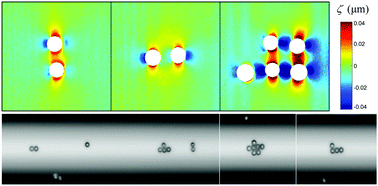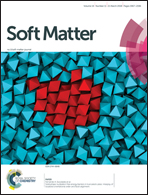Wetting, meniscus structure, and capillary interactions of microspheres bound to a cylindrical liquid interface†
Abstract
Wetting, meniscus structure, and capillary interactions for polystyrene microspheres deposited on constant curvature cylindrical liquid interfaces, constructed from nonvolatile ionic or oligomeric liquids, were studied by optical interferometry and optical microscopy. The liquid interface curvature resulted from the preferential wetting of finite width lines patterned onto planar silicon substrates. Key variables included sphere diameter, nominal (or average) contact angle, and deviatoric interfacial curvature. Menisci adopted the quadrupolar symmetry anticipated by theory, with interfacial deformation closely following predicted dependences on sphere diameter and nominal contact angle. Unexpectedly, the contact angle was not constant locally around the contact line, the nominal contact angle varied among seemingly identical spheres, and the maximum interface deviation did not follow the predicted dependence on deviatoric interfacial curvature. Instead, this deviation was up to an order-of-magnitude larger than predicted. Trajectories of neighboring microspheres visually manifested quadrupole–quadrupole interactions, eventually producing square sphere packings that foreshadow interfacial assembly as a potential route to hierarchical 2D particle structures.



 Please wait while we load your content...
Please wait while we load your content...